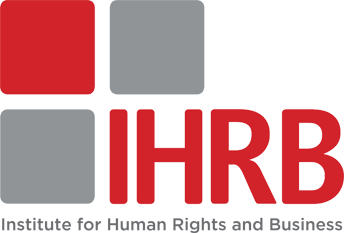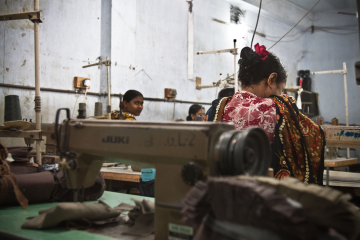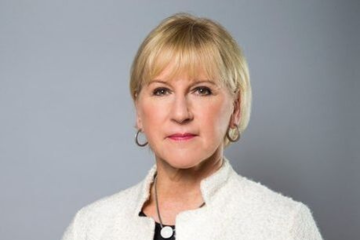The Family Planning Summit in London this week is re-invigorating efforts to ensure that women and girls around the world are able to plan their families and their futures. A main focus is on strengthening public health services and on building networks of civil society and other partners to expand rights-based family planning.
The adoption of the UN Guiding Principles on Business and Human Rights in 2011 was an important milestone for human rights. Yet, women’s health rights at work continue to be largely passed over.
But what about the corporate role in these matters – and business’ responsibility to respect human rights, including reproductive health rights, in their own operations and commercial relationships? Beginning with the World Health Organization Constitution (1946) and the Universal Declaration of Human Rights (1948), human rights instruments have progressively addressed the social determinants of health, including the workplace, occupational health and safety, and the right to sexual and reproductive health.
The adoption of the UN Guiding Principles on Business and Human Rights in 2011 was an important milestone for human rights. Yet, women’s health rights at work continue to be largely passed over.
In our recent article, Recognizing Women’s Rights at Work: Health and Women Workers in Global Supply Chains, we argue for a more expansive view of health rights at work. Greater alignment is needed between occupational safety and health (OSH) standards for workplaces and internationally recognised health rights.
The Historic Approach to Health Rights at Work
The default position of government, business, and others limits workplace health rights to traditional (i.e. OSH) standards defined by the International Labour Organization. This position is out of date and out of touch with reality. The UN Guiding Principles do not create new rights but do open the door to needed discussions about how companies uphold their role in respecting existing rights. This is especially needed given changes to the global economy, the gender makeup of the workforce, and the unjustifiable and gender-biased segregation of worker health rights as confined to “occupational health.”
Too often, the unique needs of women in low- and middle-income countries go unrecognised.
Employers can have a significant impact on the health and well-being of women workers, negative as well as positive. Too often, the unique needs of women in low- and middle-income countries go unrecognised. Access to reproductive health and family planning services is a major problem for poor women. Yet barriers can be even higher given their double burden of domestic and paid work, and because of the hours and days they work. Most public health facilities are closed after normal work hours, meaning women have limited access to health providers.
Even where enabling a worker to leave her post to receive health services on or offsite is allowed, management practices often undermine such policies.
Even where enabling a worker to leave her post to receive health services on or offsite is allowed, management practices often undermine such policies. The reason is straightforward: workplaces operating in global supply chains must meet constantly changing and urgent production demands and deadlines. The consequences of such demands are born by workers. States must ensure that public facilities, goods, services, and conditions needed for health are “accessible, available, acceptable, and of quality.” Yet many workplace infirmaries and health care providers fall short of these “AAAQ” principles and fail to meet basic public health standards for cleanliness, confidentiality, privacy, health information and referral.
Re-envisioning the Business Role in the Right to Health
The objective is not to turn corporate workplaces into public health facilities. Yet the UN Guiding Principles, in concert with other “soft law” mechanisms such as corporate global commitments and certification schemes, can spur a re-envisioning of the business role in respecting the right to health of workers.
There are four ways to advance a broader, business-beneficial approach to health rights at the workplace and improve access to women’s health service.
Here are four ways to advance a broader, business-beneficial approach to health rights at the workplace and improve access to women’s health services:
- Consider health more comprehensively: Companies should use the due diligence and human rights assessment processes expected under the UN Guiding Principles to consider women’s health more comprehensively. If such due diligence conforms only to a narrow OSH lens, then risk assessments will not ask the kinds of questions that target potential violations of women workers’ rights to quality health services, education, and information. A 2015 UN Global Compact Good Practice Note on human rights risks in supply chains emphasises that labour rights capture only a portion of all human rights, and thus companies need to “consider supply chain impacts on all human rights in and beyond the workplace.”
- Take a leadership role: Organisations and corporations that promote CSR should take a leadership role in advancing a more expansive notion of health rights at the workplace—and provide testing grounds to learn how best to achieve results. This could include incorporating some of the major guidance on health included in the “Gender Equality in Codes of Conduct” guidance document[1] released in April by Business for Social Responsibility.
- Ensure coherence: Governments and organisations involved in health policy should aim for stronger alignment between public health and occupational safety and health policies and regulations. Doing so means asking not only what additional standards and practices should apply to industry, but also how public health resources can be leveraged to help companies address worker health rights and access to family planning. One example of such an approach is the Bangladesh Ministry of Health Directorate General for Family Planning’s agreement with the Bangladesh Garment Manufacturers Export Association (BGMEA) to provide training and free contraceptives to BGMEA-qualified member factories.
- Align with the SDGs: Corporations should make women’s health rights explicit in their commitments to the UN Sustainable Development Goals (SDGs). The SDGs offer companies multiple ways to align health rights and their efforts on development, human rights, and occupational safety and health within their own operations – not just through SDG #3 (Good Health & Well-Being), but also #5 (Gender Equality), #8 (Decent Work and Economic Growth) and #17 (Partnerships), among others.
Health rights at the workplace are a best buy for business.
The London Summit organisers call family planning “a best buy in global development” as it enables women and girls to complete their education, join and advance in the workforce, and reach their full potential. Health rights at the workplace are a best buy for business. While many rights issues can be contentious, ensuring women’s and workers’ right to access health services need not be – and offers business benefits yet to be realised.
[1] The Evidence Project/Meridian Group International, Inc. contributed to the development of this guidance document.
David Wofford's contribution to this article was made possible through the Evidence Project and the support of the United States Agency for International Development (USAID) under the terms of cooperative agreement no. AID-OAA-A-13-00087. The contents of this document do not necessarily reflect the views of USAID or the United States Government.





























How should businesses respond to an age of conflict and uncertainty?
As 2024 began, European Commission President Ursula von der Leyen aptly summed up our deeply worrying collective moment. As she put it, speaking at the annual World Economic Forum in Switzerland, we are moving through “an era of conflict and...
26 March 2024 | Commentary
Commentary by Scott Jerbi, Senior Advisor, Policy & Outreach, IHRB